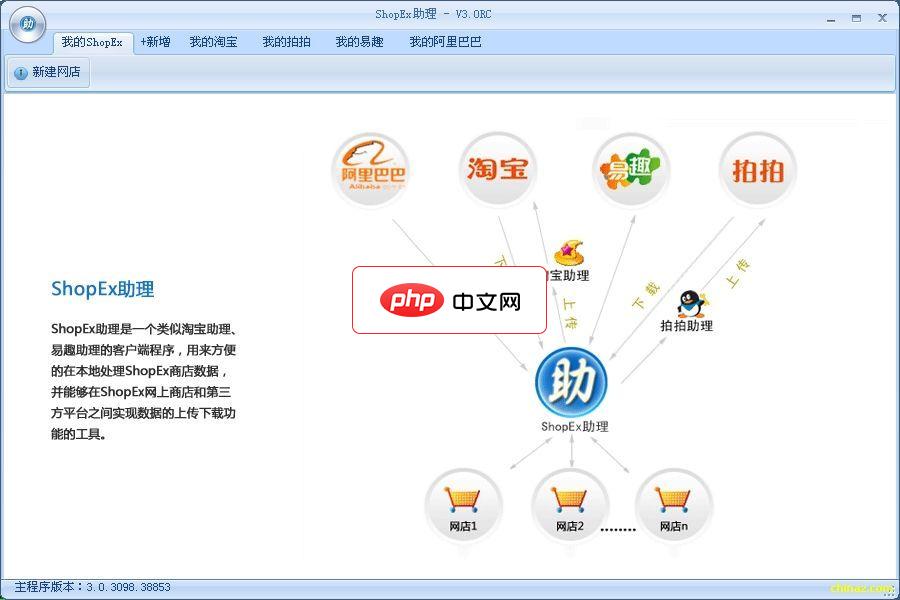随着互联网的快速发展,php作为一种服务器端脚本语言,被越来越多的人所使用。在实际项目开发中,php程序经常需要连接数据库,而数据库连接的创建和销毁是一项耗费系统资源的操作。为了避免频繁创建和销毁数据库连接,提高程序性能,一些开发者引入了数据库连接池的概念,来管理数据库连接。本文将介绍php程序中的数据库连接池最佳实践。
数据库连接池是一组数据库连接的缓存池,可以通过预先创建好一定数量的连接并保存在连接池中,当需要使用连接时,直接从连接池中获取可用连接即可,从而减少连接的创建与关闭开销。此外,它还可以控制同时开启的连接的数量。
PDO(PHP Data Object)是PHP中一个轻量级的数据库访问抽象类库,支持多种数据库系统,包括MySQL、Oracle和Microsoft SQL Server等。使用PDO连接数据库,可以有效避免SQL注入等安全问题。以下是使用PDO连接MySQL数据库的基本代码:
$pdo = new PDO('mysql:host=localhost;dbname=test;charset=utf8','user','password');实现数据库连接池需要考虑以下几个方面:
为了使连接池更加灵活,我们可以将其封装成类。以下是一个简单的数据库连接池类的实现:

一个类似淘宝助理、ebay助理的客户端程序,用来方便的在本地处理商店数据,并能够在本地商店、网上商店和第三方平台之间实现数据上传下载功能的工具。功能说明如下:1.连接本地商店:您可以使用ShopEx助理连接一个本地安装的商店系统,这样就可以使用助理对本地商店的商品数据进行编辑等操作,并且数据也将存放在本地商店数据库中。默认是选择“本地未安装商店”,本地还未安
 0
0

立即学习“PHP免费学习笔记(深入)”;
class DatabasePool {
private $min; // 连接池中最小连接数
private $max; // 连接池中最大连接数
private $exptime; // 连接过期时间
private $conn_num; // 当前连接数
private $pool; // 连接池数组
public function __construct($min, $max, $exptime) {
$this->min = $min;
$this->max = $max;
$this->exptime = $exptime;
$this->pool = array();
$this->conn_num = 0;
$this->initPool();
}
// 初始化连接池
private function initPool() {
for ($i = 0; $i < $this->min; $i++) {
$this->conn_num++;
$this->pool[] = $this->createConnection();
}
}
// 获取数据库连接
public function getConnection() {
if (count($this->pool) > 0) { // 连接池不为空
return array_pop($this->pool);
} else if ($this->conn_num < $this->max) { // 创建新的连接
$this->conn_num++;
return $this->createConnection();
} else { // 连接池已满
throw new Exception("Connection pool is full");
}
}
// 关闭数据库连接
public function releaseConnection($conn) {
if ($conn) {
if (count($this->pool) < $this->min && time() - $conn['time'] < $this->exptime) {
$this->pool[] = $conn;
} else {
$this->conn_num--;
}
}
}
// 创建数据库连接
private function createConnection() {
$time = time();
$pdo = new PDO('mysql:host=localhost;dbname=test;charset=utf8','user','password');
return array('time'=>$time, 'conn'=>$pdo);
}
}如果多个线程同时获取连接,可能会导致两个或多个线程获取到同一个连接,从而导致数据不一致。为了解决这个问题,我们可以在getConnection和releaseConnection方法中添加线程锁。该锁用于限制在同一时间只有一个线程可以进行操作:
public function getConnection() {
$this->lock();
try {
if (count($this->pool) > 0) { // 连接池不为空
return array_pop($this->pool);
} else if ($this->conn_num < $this->max) { // 创建新的连接
$this->conn_num++;
return $this->createConnection();
} else { // 连接池已满
throw new Exception("Connection pool is full");
}
} finally {
$this->unlock();
}
}
public function releaseConnection($conn) {
$this->lock();
try {
if ($conn) {
if (count($this->pool) < $this->min && time() - $conn['time'] < $this->exptime) {
$this->pool[] = $conn;
} else {
$this->conn_num--;
}
}
} finally {
$this->unlock();
}
}
private function lock() {
flock($this->pool, LOCK_EX);
}
private function unlock() {
flock($this->pool, LOCK_UN);
}通过使用数据库连接池,可以有效地节约系统资源开销,提高PHP程序的性能。在实现数据库连接池时,我们需要考虑连接池的最小值和最大值、连接过期时间、连接的创建、获取与释放以及线程安全等问题。希望本文所介绍的数据库连接池最佳实践能够对大家有所帮助。
以上就是PHP程序中的数据库连接池最佳实践的详细内容,更多请关注php中文网其它相关文章!

PHP怎么学习?PHP怎么入门?PHP在哪学?PHP怎么学才快?不用担心,这里为大家提供了PHP速学教程(入门到精通),有需要的小伙伴保存下载就能学习啦!

Copyright 2014-2025 https://www.php.cn/ All Rights Reserved | php.cn | 湘ICP备2023035733号